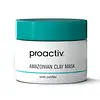What's inside
What's inside
 Key Ingredients
Key Ingredients

 Benefits
Benefits

 Concerns
Concerns

 Ingredients Side-by-side
Ingredients Side-by-side

Water
Skin ConditioningKaolin
AbrasiveGlycerin
HumectantPetrolatum
EmollientCetearyl Alcohol
EmollientPropanediol
SolventStearyl Alcohol
EmollientBentonite
AbsorbentPEG-100 Stearate
Glyceryl Stearate
EmollientButyrospermum Parkii Butter
Skin ConditioningMagnesium Aluminum Silicate
AbsorbentPyrus Malus Fruit Extract
Skin ConditioningPersea Gratissima Oil
Skin ConditioningXanthan Gum
EmulsifyingSorbitan Stearate
EmulsifyingPhenoxyethanol
PreservativeCaprylyl Glycol
EmollientCucumis Sativus Seed Oil
EmollientHexylene Glycol
EmulsifyingEthylhexylglycerin
Skin ConditioningCitric Acid
BufferingGlyceryl Acrylate/Acrylic Acid Copolymer
HumectantWater, Kaolin, Glycerin, Petrolatum, Cetearyl Alcohol, Propanediol, Stearyl Alcohol, Bentonite, PEG-100 Stearate, Glyceryl Stearate, Butyrospermum Parkii Butter, Magnesium Aluminum Silicate, Pyrus Malus Fruit Extract, Persea Gratissima Oil, Xanthan Gum, Sorbitan Stearate, Phenoxyethanol, Caprylyl Glycol, Cucumis Sativus Seed Oil, Hexylene Glycol, Ethylhexylglycerin, Citric Acid, Glyceryl Acrylate/Acrylic Acid Copolymer
Water
Skin ConditioningMontmorillonite
AbsorbentIllite
AbrasiveSqualane
EmollientGlycerin
HumectantCetearyl Alcohol
EmollientCetearyl Olivate
Sodium Lauroyl Lactylate
EmulsifyingKaolin
AbrasiveSorbitan Olivate
EmulsifyingPropanediol
SolventMelaleuca Alternifolia Leaf Oil
AntioxidantOcimum Sanctum Leaf Extract
Skin ConditioningCentella Asiatica Extract
CleansingLavandula Angustifolia Oil
MaskingCamellia Sinensis Leaf Powder
ExfoliatingPhenoxyethanol
PreservativeEthylhexylglycerin
Skin ConditioningPotassium Sorbate
PreservativeSodium Phytate
Linalool
PerfumingWater, Montmorillonite, Illite, Squalane, Glycerin, Cetearyl Alcohol, Cetearyl Olivate, Sodium Lauroyl Lactylate, Kaolin, Sorbitan Olivate, Propanediol, Melaleuca Alternifolia Leaf Oil, Ocimum Sanctum Leaf Extract, Centella Asiatica Extract, Lavandula Angustifolia Oil, Camellia Sinensis Leaf Powder, Phenoxyethanol, Ethylhexylglycerin, Potassium Sorbate, Sodium Phytate, Linalool
Ingredients Explained
These ingredients are found in both products.
Ingredients higher up in an ingredient list are typically present in a larger amount.
Cetearyl alcohol is a mixture of two fatty alcohols: cetyl alcohol and stearyl alcohol. It is mainly used as an emulsifier. Emulsifiers help prevent the separation of oils and products. Due to its composition, it can also be used to thicken a product or help create foam.
Cetearyl alcohol is an emollient. Emollients help soothe and hydrate the skin by trapping moisture.
Studies show Cetearyl alcohol is non-toxic and non-irritating. The FDA allows products labeled "alcohol-free" to have fatty alcohols.
This ingredient is usually derived from plant oils such as palm, vegetable, or coconut oils. There is debate on whether this ingredient will cause acne.
Due to the fatty acid base, this ingredient may not be Malassezia folliculitis safe.
Learn more about Cetearyl AlcoholEthylhexylglycerin (we can't pronounce this either) is commonly used as a preservative and skin softener. It is derived from glyceryl.
You might see Ethylhexylglycerin often paired with other preservatives such as phenoxyethanol. Ethylhexylglycerin has been found to increase the effectiveness of these other preservatives.
Glycerin is already naturally found in your skin. It helps moisturize and protect your skin.
A study from 2016 found glycerin to be more effective as a humectant than AHAs and hyaluronic acid.
As a humectant, it helps the skin stay hydrated by pulling moisture to your skin. The low molecular weight of glycerin allows it to pull moisture into the deeper layers of your skin.
Hydrated skin improves your skin barrier; Your skin barrier helps protect against irritants and bacteria.
Glycerin has also been found to have antimicrobial and antiviral properties. Due to these properties, glycerin is often used in wound and burn treatments.
In cosmetics, glycerin is usually derived from plants such as soybean or palm. However, it can also be sourced from animals, such as tallow or animal fat.
This ingredient is organic, colorless, odorless, and non-toxic.
Glycerin is the name for this ingredient in American English. British English uses Glycerol/Glycerine.
Learn more about GlycerinKaolin is a clay. It is used for oil control and to help minimize pores. Like other clays, kaolin has the ability to absorb excess sebum or oil. This can help clean out pores and mattify the skin.
Some types of kaolin may have exfoliating properties. When water is added to kaolin, it becomes a paste with small abrasive particles.
Most kaolin is a white color, but may be pink/orange/red depending on where it comes from.
The name 'kaolin' comes from a Chinese village named 'Gaoling'. Kaolin clay comes from rocks rich in kaolinite. Kaolinite, the mineral, has a silicate layered structure. Kaolinite is formed from chemical weathering of aluminum siilicate minerals.
Besides skincare, kaolin is commonly used to make glossy paper, in ceramics, toothpaste, and as medicine to soothe stomach issues.
Learn more about KaolinPhenoxyethanol is a preservative that has germicide, antimicrobial, and aromatic properties. Studies show that phenoxyethanol can prevent microbial growth. By itself, it has a scent that is similar to that of a rose.
It's often used in formulations along with Caprylyl Glycol to preserve the shelf life of products.
Propanediol is an all-star ingredient. It softens, hydrates, and smooths the skin.
It’s often used to:
Propanediol is not likely to cause sensitivity and considered safe to use. It is derived from corn or petroleum with a clear color and no scent.
Learn more about PropanediolWater. It's the most common cosmetic ingredient of all. You'll usually see it at the top of ingredient lists, meaning that it makes up the largest part of the product.
So why is it so popular? Water most often acts as a solvent - this means that it helps dissolve other ingredients into the formulation.
You'll also recognize water as that liquid we all need to stay alive. If you see this, drink a glass of water. Stay hydrated!
Learn more about Water